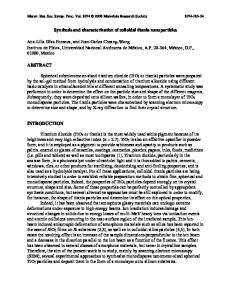Synthesis and Characterization of Cu x (In, Ga) y Se z Nanoparticles by Colloidal Route
- PDF / 491,643 Bytes
- 6 Pages / 595 x 842 pts (A4) Page_size
- 37 Downloads / 351 Views
L5.9.1
Synthesis and Characterization of Cux(In,Ga)ySez Nanoparticles by Colloidal Route Ki-Hyun Kim1,2, Young-Gab Chun1, Byung-Ok Park2 and Kyung-Hoon Yoon*1 1 Solar Cells Research Center, Korea Institute of Energy Research, 71-2 Jang-dong, Yusong-gu, Daejeon, 305-343, Republic of Korea * Tel: +82-42-860-3191/ Fax: +82-42-860-3739/ E-mail: [email protected] 2 Dept. of Inorganic Materials Engineering, Kyungpook National University, 1370 Sankyuk-dong, Puk-ku, Daegu, 702-701, Republic of Korea ABSTRACT The quarternary CIGS nanoparticles for absorber layer of solar cells have been synthesized with various mole ratios by colloidal route. The CIGS nanoparticles were prepared by reacting CuI, InI3, GaI3 in pyridine with Na2Se in methanol at 0℃ under inert atmosphere. For Cu0.9In0.8Ga0.3Se2 and Cu0.9In0.7Ga0.4Se2 stoichiometric ratios, tube-type nanofibers were obtained with the widths in the range of 20-50 ㎚ and lengths of 0.1-3 ㎛ from reaction at 0℃ for 20 min. For Cu1.1In0.68Ga0.23Se1.91, and Cu0.9In0.68Ga0.23Se1.91 ratios, spherical nanoparticles were obtained from the same reaction condition. As compared to particles from Cu0.9In0.68Ga0.23Se1.91 ratio, more uniform and smaller nanoparticles with diameter in the range of 5-20 ㎚ were obtained from the Cu1.1In0.68Ga0.23Se1.91 stoichiometric ratio. The morphology change of the CIGS particles seems to be closely related to the ratio of Cu/(In,Ga). INTRODUCTION The synthesis of nanostructure semiconductors has been of interest to material scientist and chemists because of their potential applications in recent years [1-5]. Compared with microscale material, the nanoscale materials have potential application in both mesoscopic research and development of nanodevices [6-7]. The I-III-VI2 nanoscale materials, ternary and quaternary semiconductor compounds such as CuInSe2 (CIS) and CuInGaSe2 (CIGS) with the chalcopyrite structure have shown to be useful as nonlinear optical and direct energy gap materials [8-9]. The CIGS is known to be a very prominent absorber layer for high efficiency thin film solar cell devices. Most of the research groups developing CIGS solar cells have used physical vapor deposition (PVD) techniques such as evaporation [10] or sputtering [11] for depositing the absorber layer of CIGS. However, it is expensive to manufacture photovoltaic (PV) device by PVD method and it is difficult with almost of these methods to obtain satisfactory stoichiometric compound. In order to overcome such problem, it has been tried to use nanoparticles for solar cells device by non-vacuum and low temperature processes. The colloidal route of non-vacuum process allows to prepare the CIGS semiconductor compounds for absorber layer without high-pressure Se vapor treatment and H2Se treatment of Cu-In-Ga alloys. In this work, a novel approach has been tried to fabricate CIGS solar cells in which a non-
L5.9.2
vacuum process has been employed for depositing the CIGS absorber layer. We have synthesized CIGS nanoparticles by colloidal route and address some characteristic features o
Data Loading...











